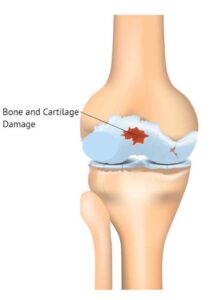Knee Osteochondral Defect Specialist

Are you experiencing pain with weight bearing? Do you have a locking sensation in your knee with swelling or decreased range of motion? If so, you may have an osteochondral defect, which is a condition that affects the articular cartilage of the knee. Knee osteochondral defect specialist, Doctor Riley J. Williams provides diagnosis and both surgical and nonsurgical treatment options for patients in Manhattan, Brooklyn, New York City and surrounding areas who are experiencing symptoms associated with knee osteochondral defects or articular cartilage damage. Contact Dr. Williams’ team today!
What is an osteochondral defect?
Osteochondral defects can occur in any joint in the human body, but are most commonly seen in the knee. “Osteo” means bone, and chondral means cartilage. An osteochondral defect occurs when there is a focal area of damage to the articular cartilage and the underlying bone. Osteochondral defects can develop over time as part of the aging process and often go undiagnosed until there is a significant increase of pain or the development of mechanical symptoms (knee catching and locking). It is not unusual for patients to be unable to pinpoint the exact or mechanism of injury unless the injury is severe.
Is OCD (Osteochondritis Dissecans) the same thing as an osteochondral Defect?
Osteochondritis Dissecans (OCD) is a type of osteochondral defect. The two clinical conditions are closely related. Osteochondritis Dissecans and osteochondral defects can occur in any joint, but frequently occur in the knee joint. OCD lesions are characterized by an area of abnormal bone (dead or necrotic bone) that lies below an area of normal cartilage. Over time, the cartilage over this area of abnormal bone starts to detach or collapse because the underlying bone is soft and abnormal. Most OCD lesions are present at birth; symptoms associated with OCD lesions typically occur in the second to third decades of life. The exact cause of OCD lesions is unknown; OCD lesions are thought to be caused by micro-traumas to the knee that occur in utero. OCD lesions are congenital. Although OCD lesions are a type of osteochondral defect, there are other types of osteochondral lesions that involve damage to the articular cartilage and can affect the underlying bone. The distinction between the two conditions is the congenital nature of osteochondritis dissecans, and the abnormal bone of OCD that ultimately results in an overlying cartilage lesion. Many physicians will use these two terms interchangeably.
What are the symptoms of an osteochondral defect?
Symptoms of an osteochondral defect that involves the cartilage and the underlying bone include;
- Pain with weightbearing activities
- Swelling
- Catching or locking sensation in the knee
- Instability of the knee joint
- Decreased range of motion
- Tenderness, often felt in the center of the knee
- Inability to fully extend or flex the knee joint
How are osteochondral defects diagnosed?
It is not unusual for an osteochondral defect to go undiagnosed for years. Some defects occur as part of the aging process, are progressive and get worse over time. Other such osteochondral defects occur with a traumatic episode such as an accident or hard fall. Dr. Riley J. Williams will use an MRI Scan to diagnose an osteochondral defect. The MRI will show him the articular cartilage surfaces. The MRI scan will allow Dr. Williams to determine the size, shape and progression of the injury. If the bone has been affected, he will be able to determine the amount of bone damage and can formulate a plan for treatment and repair of the osteochondral defect.
What is the treatment for an osteochondral defect?
Treatment for this type of knee injury or defect will vary, based on the patient’s activity level and on the size, location and amount of damage caused by the defect.
Non-surgical treatment:
The goal of conservative treatment is to reduce pain and inflammation in the joint. This can often be done with the use of non-steroidal anti-inflammatory medication, such as ibuprofen or naproxen. Hot and cold therapy, as well as rest, and activity modification are recommended. A physical therapy program that involves strengthening the muscles around the knee joint and lower extremity will help to alleviate pain and can help patients retain flexibility and range of motion.
Surgical treatment:
Doctor Williams has extensive experience and success in treating osteochondral defects. He offers proven, up-to-date treatments for his patients in New York and the surrounding areas. Surgical treatment for osteochondral defects may include:
- Debridement, removal of loose cartilage, chondroplasty
- Microfracture
- Autograft Mosaicplasty
- Osteochondral Allograft Transplantation
- MACI – Matrix Associated Autologous Chondrocyte Implantation
- Particulate Juvenile Articular Cartilage
- Stem Cell Injections
For more information on osteochondral defects and other articular cartilage injuries as well as the different treatment options available for your knee cartilage injury, please contact the office of Riley Williams, MD, knee specialist serving Manhattan, Brooklyn, New York City, NY and surrounding areas.
Locations
610 W 58th Street
New York, NY 10019
148 39th Street, 7th Floor
Brooklyn, NY 11232




